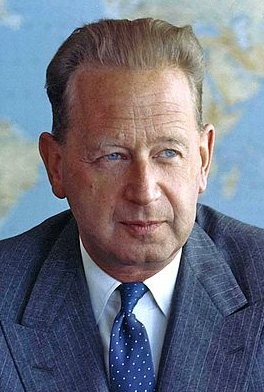| Profile | Major Works | Resources |
Dag Hammarskjöld, 1905-1961.

Swedish Stockholm School economist and civil servant. Later better known as Secretary-General of the United Nations organization from 1953 until his death in 1961
Dag Hammarskjöld came from a distinguished Swedish family, his father Hjalmar Hammarskjöld having served as prime minister of Sweden in 1914-17. Dag Hammarsjkold studied at Uppsala for his undergraduate degree, and then received his doctorate at the University of Stockholm, with a dissertation on economic fluctuations written under Gunnar Myrdal. Hammarskjold's 1933 article is a classic piece of the Stockholm School, where develops a mathematical model formalizing the incongruity between ex ante plans and ex post results.
Hammarskhold taught at the university of Stockholm from 1933 until 1936, when he abandoned academia and transitioned into public service. Hammarskjold served initially in the Swedish ministry of Finance from 1936 to 1945, and, from 1941 to 1948, as chairman of the board of the Riksbank, the Swedish central bank. Dag Hammarskjold went on to serve on the Swedish delegation to the United Nations. He was elected 1953 as Secretary-General of the UN, succeeded the first holder Tryvie Lie. Dammarskjold died in a plane crash in 1961 near Ndola, Zambia, while shuttling on a peace mission to end the Congo civil war. He received the Nobel Peace Prize posthumously in 1961.
|
Major Works of Dag Hamarskjold
|
|
HET
|
|
Resources on Dag Hamarskjold
|
All rights reserved, Gonçalo L. Fonseca
